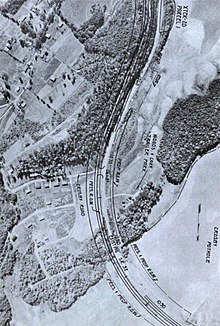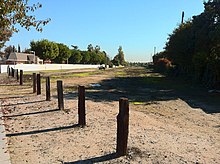Right-of-way (property access)
This article needs additional citations for verification. (September 2021) |


A right-of-way (ROW, not to be confused with "
A right of way is granted or reserved over the land for
Rail right-of-way
In the United States, railroad rights-of-way (ROW or R/O/W) are generally considered private property by the respective railroad owners and by applicable state laws. Most U.S. railroads employ their own police forces, who can arrest and prosecute trespassers found on their rights-of-way. Some railroad rights-of-way include recreational rail trails.
In Canada, railroad rights-of-way are regulated by federal law.
In the
Designations of railroad right of way

The various designations of railroad right of way are as follows:
- Active track is any track that is used regularly or even only once in a while.
- Out of service means the right of way is preserved, and the railroad retains the right to activate it. The line could be out of service for decades. Thus track or crossings that have been removed need to be replaced.
- By an embargo the track is removed, but the right of way is preserved and usually is converted into a walking or cycling path or other such use.
- An abandonment is a lengthy formal process by which the railroad gives up all rights to the line. In most cases the track is removed and sold for scrap and any grade crossings are redone. The line will never be active again. The right of way reverts to the adjoining property owners.
Rail rights-of-way uses other than rail transport

Railroad rights-of-way need not be exclusively for railroad tracks and related equipment.
Concerns about constructions of buildings around rail right-of-way
Many experts are concerned about construction of houses/buildings around rail right-of-way does not pay attention to safety aspects — the distance between rail right-of-way and houses/buildings that are too close is dangerous — rail right-of-way is a train blind spot area that must be avoided. For example, in Vietnam — Hanoi Department of Tourism ordered to close cafes and shops along Hanoi Train Street will be closed for the safety despite being a popular tourist destination for foreign tourists in Vietnam.[3]
See also
- Eminent domain
- Noise barrier
- Permanent way
- Right of way (public throughway)
- Right of way (traffic)
- Rights of way in England and Wales
References
- ^ Henry Campbell Black: Right-of-way. In: A law dictionary containing definitions of the terms and phrases of American and English jurisprudence, ancient and modern: and including the principal terms of international, constitutional, ecclesiastical, and commercial law, and medical jurisprudence, with a collection of legal maxims ... (West Publishing Co., 1910), pg. 1040.
- ^ Henry Campbell Black: Right-of-way. In: A law dictionary containing definitions of the terms and phrases of American and English jurisprudence, ancient and modern: and including the principal terms of international, constitutional, ecclesiastical, and commercial law, and medical jurisprudence, with a collection of legal maxims ... (West Publishing Co., 1910), pg. 1040.
- ^ "Tours of coffee shops along Hanoi train street prohibited". Vietnamplus. 5 April 2023. Retrieved 2 May 2024.
